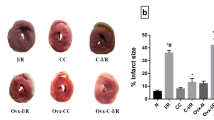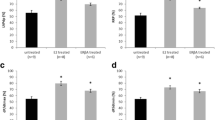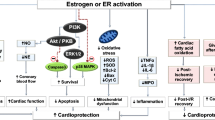Abstract
The purpose of this study is to examine the antiarrhythmic and antioxidant effects of tamoxifen, one of the selective estrogen modulators, in ovariectomized rats subjected to myocardial ischemia-reperfusion (I/R) injury. A month after ovariectomy, rats were divided into four groups: (I) ovariectomized controls without any treatment, (II) ovariectomized rats treated with vehicle dimethylsulfoxide (DMSO), (III)–(IV) ovariectomized rats treated with tamoxifen 1 or 10 mg/kg,sc daily for 14 days. To produce arrhythmia, the left main coronary artery was occluded for 7 min, followed by 7 min of reperfusion. The blood pressure (BP), heart rate (HR), electrocardiography (ECG) was recorded before and during the ischemia-reperfusion period. The blood levels of malondialdehyde (MDA), creatine kinase (CK), glutathione (GSH), glutathione peroxidase (GSH-Px), glutathione reductase (GR), and catalase (CAT) were measured after the rats were killed. Tamoxifen reduced the incidence of ventricular tachycardia (VT) on ischemia and reperfusion as well as the incidence and duration of reversible ventricular fibrillation (VF) on reperfusion. I/R injury caused a significant fall in GSH, GSH-Px as well as an increase in MDA and CK levels in the control group when compared to tamoxifen treated groups. The changes in levels of CAT and GR were however, not significant. In conclusion, our findings suggest that tamoxifen has cardioprotective effects against I/R injury in rats, likely its antioxidant properties.


Similar content being viewed by others
References
Weber KT, Janicki JS (1979) The metabolic demand and oxygen supply of the heart: physiologic and clinical considerations. Am J Cardiol 44:722–729
Hearse DJ (1990) Ischemia, reperfusion and the determinants of tissue injury. Cardiovasc Drug Ther 4:767–776
Harden WR, Barlow CH, Simson MB et al (1979) Myocardial ischemia and left ventricular failure in the isolated perfused rabbit heart. Am J Cardiol 44:741–746
Braunwald E, Kloner RA (1985) Myocardial reperfusion: a double-edged sword. J Clin Invest 76:1713–1719
Bolli R, Marban E (1999) Molecular and cellular mechanism in myocardial stunning. Physiol Rev 79:609–634
Grech ED, Bellamy CM, Jackson MJ et al (1994) Free radical activity after primary coronary angioplasty in acute myocardial infarction. Am Heart J 127:1443–1449
Temsah RM, Netticadan T, Dhalla NS (2003) Mechanisms of cellular alterations due to ischemia-reperfusion injury in the heart. In: Dhalla NS, Takeda N, Singh M, Lukas A (eds) Myocardial ischemia and preconditioning. Kluwer Academic Publishers, Boston, pp 149–164
Dhalla NS, Panagia V, Singal PK et al (1988) Alterations in heart membrane calcium transport during the development of ischemia-reperfusion injury. J Mol Cell Cardiol 20(suppl 2):3–13
Tani M (1990) Mechanisms of Ca2+ overload in reperfused myocardium. Annu Rev Physiol 52:543–559
Ceconi C, Curello S, Cargnoni A et al (1988) The role of glutathione status in the protection against ischemic and reperfusion damage: effects of N-acetyl cysteine. J Mol Cell Cardiol 20:5–13
Ferrari R, Alfieri O, Curello S et al (1990) Occurrence of oxidative stress during reperfusion of the human heart. Circulation 81:201–211
Ferrari R, Ceconi C, Curello S et al (1991) Oxygen free radicals and myocardial damage: protection with thiol containing agents. Am J Med 91:S95–S105
Otani H, Engelman RM, Rousou JA et al (1986) Cardiac performance during reperfusion improved by pretreatment with oxygen free-radical scavengers. J Thorac Cardiovasc Surg 91:290–295
Dhalla NS, Elmoselhi AB, Hata T et al (2000) Status of myocardial antioxidants in ischemia-reperfusion injury. Cardiovasc Res 47: 446–456
Krishenbaum LA, Singal PK (1993) Increase in endogenous antioxidant enzymes protects hearts against reperfusion injury. Am J Physiol 265:H484–H493
Vergely C, Perrin C, Laubriet A et al (2001) Postischemic myocardial recovery and oxidative stress status of vitamin C deficient rat hearts. Cardiovasc Res 51:89–99
Valko M, Leibfritz D, Moncol J et al (2007) Free radicals and antioxidants in normal physiological functions and human disease. Int J Biochem Cell Biol 39:44–84
Kasparova S, Brezova V, Valko M et al (2005) Study of the oxidative stress in a rat model of chronic brain hypoperfusion. Neurochem Int 46:601–611
Herrington DM, Klein KP (2001) Effects of SERM’s on important indicators of cardiovascular health: lipoproteins, hemostatic factors, endothelial function. Womens Health Issues 11:95–102
Kaya H, Ozkaya O, Sezik M et al (2005) Effects of raloxifene on serum malondialdehyde, erythrocyte superoxide dismutase, and erythrocyte glutathione peroxidase levels in healthy postmenopausal women. Maturitas 50:182–188
Stevenson M, Lloyd Jones M, De Nigris E et al (2005) A systematic review and economic evaluation of alendronate, etidronate, risedronate, raloxifene and teriparatide for the prevention and treatment of postmenopausal osteoporosis. Health Technol Assess 9:1–160
Bernardi F, Pluchino N, Stomati M et al (2003) CNS: sex steroids and SERM’s. Ann N Y Acad Sci 997:378–388
Harman SM (2006) Estrogen replacement in menopausal women: recent and current prostective studies, the WHI and The KEEPS. Gend Med 3:254–269
McDonald CC, Stewart HJ (1991) Fatal myocardial infarction in the Scottish adjuvant tamoxifen trial. Scottish Breast Cancer Committee BMJ 303:435–437
Early Breast Cancer Trialists’ Collaborative Group (1992) Systemic treatment of early breast cancer by hormonal, cytotoxic, or immune therapy: 133 randomized trials involving 31000 recurrences and 24000 deaths among 75000 women. Lancet 339:71–85
Clarke SC, Schofield PM, Grace AA et al (2001) Tamoxifen effects on endothelial function and cardiovascular risk factors in men with advanced atherosclerosis. Circulation 103:1497–1502
Li X, Takabashi M, Kushida K et al (1998) The less potent estrogenic effect of tamoxifen on bone in ovariectomized rats with established osteopenia. Calcif Tissue Int 62:502–505
Pham-Dang ML, Clement R, Mercier I et al (2003) Comparative effects of tamoxifen and angiotensin II type-1 receptor antagonist therapy on the hemodynamic profile of the ovariectomized rat. Can J Physiol Pharmacol 81:915–919
Aktug H, Uslu S, Terek MC et al (2006) Effects of ovariectomy and tamoxifen on rat bone tissue: histomorphometric and histopathologic study. Anal Quant Cytol Histol 28:207–212
Guc MO, Boachie-Ansah G, Kane KA et al (1993) Comparison of antiarrhythmic and electrophysiologic effects of diltiazem and its analogue siratiazem. J Cardiovasc Pharmacol 22:681–686
Olmez E, Birincioglu M, Aksoy T et al (1995) Effects of captopril on ischemia-reperfusion-induced arrhythmias in an in vivo rat model. Pharmacol Res 82:37–41
Ozer MK, Sahna E, Birincioglu M et al (2002) Effects of captopril and losartan on myocardial ischemia-reperfusion induced arrhythmias and necrosis in rats. Pharmacol Res 45:257–263
Walker MJ, Curtis MJ, Hearse DJ et al (1988) The Lamberth Conventions: guidelines for the study of arrhythmias in ischemia infarction and reperfusion. Cardiovasc Res 22:447–455
Tietze F (1969) Enzymatic method for quantitative determination of nano gram amounts of total and oxidized glutathione. Applications to mammalian blood and other tissues. Anal Biochem 27:502–522
Ohkawa H, Ohishi N, Yagi, K (1979) Assay for lipid peroxides in animal tissues by thiobarbituric acid reaction. Anal Biochem 95:351–358
Racker E (1955) Glutathione reductase (liver and yeast). In: Colowick SP, Kaplan NO (eds) Methods in enzymology, vol 2. Academic Press, New York
Aebi H (1974) Catalase. In: Bergmeyer HU (ed) Methods of enzymatic analysis. Academic Press, New York, pp 673–677
Paglia DE, Valentine WN (1967) Studies on the quantitative and qualitative characterization of erythrocyte peroxidase. J Lab Clin Med 2:158
Dhalla NS, Goffman L, Takeda S et al (1999) Evidence for the role of oxidative stress in acute ischemic heart disease: a brief review. Can J Cardiol 15:587–593
Marczin N, El-Habashi N, Hoare GS et al (2003) Antioxidants in myocardial ischemia-reperfusion injury: therapeutic potential and basic mechanisms. Arch Biochem Biophys 420:222–236
Kim SJ, Depre C, Vatner SF (2003) Novel mechanisms mediating stunned myocardium. Heart Fail Rev 8:143–153
Myers ML, Webb C, Moffat M et al (1991) Activated neutrophils depress myocardial function in the perfused rabbit heart. Can J Cardiol 7:323–330
Kukreja RC, Weaver AB, Hess ML (1989) Stimulated human neutrophils damage cardiac sarcoplasmic reticulum function by generation of oxidants. Biochim Biophys Acta 990:198–205
Schulz R, Dodge KL, Lopaschuk GD et al (1997) Peroxynitrite impairs cardiac contractile function by decreasing cardiac efficiency. Am J Physiol Heart Circ Physiol 272:H1212–H1219
Xie YW, Kaminski PM, Wolin MS (1998) Inhibition rat cardiac muscle contraction and mitochondrial respiration by endogenous peroxynitrite formation during posthypoxic reoxygenation. Circ Res 82:891–897
Oyama J, Shimokawa H, Momii H et al (1998) Role of nitric oxide and peroxynitrite in the cytokine-induced sustained myocardial dysfunction in dogs in vivo. J Clin Invest 101:2207–2214
Poderoso JJ, Peralta JG, Lisdero CL et al (1998) Nitric oxide regulates oxygen uptake and hydrogen peroxide release by the isolated beating rat heart. Am J Physiol Cell Physiol 274:C112–C119
Xu KY, Zweier JL, Becker LC (1997) Hydroxyl radical inhibits sarcoplasmic reticulum Ca2+ATPase function by direct attack on the ATP binding site. Circ Res 80:76–81
Murphy JG, Smith TW, Marsh JD (1988) Mechanisms of reoxygenation-induced calcium overload in cultured chick embryo heart cells. Am J Physiol Heart Circ Physiol 254:H1133–H1141
Nayler WG, Panagiotopoulos S, Elz JS et al (1988) Calcium-mediated damage during post-ischemic reperfusion. J Mol Cell Cardiol 20(Supl 2):41–54
Billman GE, Mcllroy B, Johnson JD (1991) Elevated myocardial calcium and its role in sudden cardiac death. FASEB J 5:2586–2592
Lee JA, Allen DG (1991) Mechanisms of acute ischemic contractile failure of the heart. Role of intracellular calcium. J Clin Invest 88:361–367
Van Eyk JE, Powers F, Law W et al (1998) Breakdown and release of myofilament proteins during ischemia and ischemia/reperfusion in rat hearts: identification of degradation products and effects on the pCa-force relation. Circ Res 82:261–271
Gao WD, Liu Y, Mellgren R et al (1996) Intrinsik myofilament alterations underlying the decreased contractility of stunned myocardium. A consequence of Ca2+ dependent proteolysis? Circ Res 78:455–465
Barbato R, Menabo R, Dainese P et al (1996) Binding of ctyosolic proteins to myofibrils in ischemic rat hearts. Circ Res 78:821–828
Foster DB, Noguchi T, VanBuren P et al (2003) C-terminal truncation of cardiac troponin I causes divergent effects on ATPase and force: implications for the pathophysiology of myocardial stunning. Circ Res 93:917–924
Canton M, Neverova I, Menabo R et al (2004) Evidence of myofibrillar protein oxidation induced by postischemic reperfusion in isolated rat hearts. Am J Physiol Heart Circ Physiol 286:H870–H877
Powell SR, Gurzenda EM, Wahezi SM (2001) Actin is oxidized during myocardial ischemia. Free Radic Biol Med 30:1171–1176
Mekhfi H, Veksler V, Mateo P et al (1996) Creatine kinase is the main target of reactive oxygen species in cardiac myofibrils. Circ Res 78:1016–1027
Suzuki S, Kaneko M, Chapman DC et al (1991) Alterations in cardiac contractile proteins due to oxygen free radicals. Biochim Biophys Acta 1074:95–100
Dhalla NS, Saini HK, Tappia PS et al (2007) Potential role and mechanisms of subcellular remodeling in cardiac dysfunction due to ischemic heart disease. J Cardiovasc Med 8:238–250
Hicks JJ, Montes-Cortes DH, Cruz-Dominguez MP et al (2007) Antioxidants decrease reperfusion induced arrhythmias in myocardial infarction with ST-elevation. Front Biosci 12:2029–2037
Burger HG, Teede HJ (2007) Endocrine changes during the perimenopause. In: Studd J (ed) Treatment of the postmenopausal woman: basic and clinical aspects, 3rd ed. Elsevier, New York
Teede HJ (2003) Hormone replacement therapy and the effects on cardiovascular and cerebrovascular disease. Best Pract Clin Endocrinol Metab 17:73–90
Grady D, Rubin SM, Petitti DB et al (1992) Hormone therapy to prevent disease and prolong life in postmenopausal women. Ann Intern Med 117:1016–1037
Grodstein F, Stampfer MJ, Colditz GA et al (1997) Postmenopausal hormone therapy and mortality. N Engl J Med 336:1769–1775
DeMeersman RE, Zion AS, Giardina E et al (1998) Estrogen replacement, vascular distensibility, and blood pressure in postmenopausal women. Am J Physiol 274:H1539–H1544
Sung BH, Ching M, Izzo JL et al (1999) Estrogen improves abnormal norepinephrine-induced vasoconstriction in post-menopausal women. J Hypertens 17:523–528
Steptoe A, Fieldman G, Evans O et al (1996) Cardiovascular risk and responsivity to mental stress. The influence of age, gender and risk factors. J Cardiovasc Risk 3:83–93
Du XJ, Riemersma RA, Dart AM (1995) Cardiovascular protection by estrogen is partly mediated through modulation of autonomic nervous function. Cardiovasc Res 30:161–165
Sourander L, Rajala T, Helenious H (1998) Cardiovascular and cancer morbidity and mortality and sudden cardiac death in postmenopausal women on ERT. Lancet 352:1965–1969
Burger HG (2006) Hormone therapy in the WHI era. Aust N Z J Obstet Gynaecol 46: 8–91
Hulley S, Grady D, Bush T et al (1998) Randomized trial of estrogen plus progestin for secondary prevention of coronary heart disease in postmenopausal woman. JAMA 288:321–333
Rossouw JE, Anderson GL, Prentice RL et al, Writing Group for the Women’s Health Initiative Investigators (2000) Risks and benefits of estrogen plus progestin in healthy postmenopausal women: principal results from the Women’s Health Initiative randomized controlled trial. JAMA 288:321–333
Manson JE, Bassuk SS, Harman SM et al (2006) Postmenopausal hormone therapy: new questions and the case for new clinical trials. Menopause 13:139–147
Mitlak BH, CohenFJ (1997) In search of optimal long-term female estrogen replacement: the potential of selective estrogen receptor modulators. Hor Res 48:155–163
Purdie DW, Beardsworth SA (1999) The selective estrogen receptor modulation: evaluation and clinical application. Br J Clin Pharmacol 48:785–792
Mobasseri S, Liebson PR, Klein LW (2004) Hormone therapy and selective estrogen receptor modulators for prevention of coronary heart disease in postmenopausal women. Cardiol Rev 12:287–298
Waters DD (2002) Estrogen therapy for unstable angina (editorial). J Am Coll Cardiol 39:238–240
Ferrara A, Quesenberry CP, Karter AJ et al (2003) Current use of unopposed estrogen and progestin and risk of acute myocardial infarction among women with diabetes. The Northern California Kaiser Permanente Diabetes Registry, 1995–1998. Circulation 107:43–48
McDonald CC, Alexander FE, Whyte BW et al (1995) Cardiac and vascular morbidity in women receiving adjuvant tamoxifen for breast cancer in a randomized trial. BMJ 311:977–980
Costantino JP, Kuller LH, Ives DG et al (1997) Coronary heart disease mortality and adjuvant tamoxifen therapy. J Natl Cancer Inst 89:776–782
Figtree GA, Webb CM, Collins P (2000) Tamoxifen acutely relaxes coronary arteries by an endothelium-, nitric oxide-, and estrogen receptor-dependent mechanism. J Pharmacol Exp Ther 295:519–523
Hutchison SJ, Chou TM, Chatterjee K et al (2001) Tamoxifen is an acute, estrogen like, coronary vasodilator of porcine coronary arteries in vitro. J Cardiovasc Pharmacol 38:657–665
Song J, Stanley PR, Zhang F et al (1996) Tamoxifen (estrogen antagonist) inhibits voltage-gated calcium current and contractility in vascular smooth muscle from rats. J Pharmacol Exp Ther 277:1444–1453
Thorin E, Pham-Dang M, Clement R et al (2003) Hyper-reactivity of cerebral arteries from ovariectomized rats: therapeutic benefit of tamoxifen. Br J Pharmacol 140:1187–1192
Tsang SY, Yao X, Chan FL et al (2004) Estrogen and tamoxifen modulate cerebrovascular tone in ovariectomized female rats. Hypertension 44:78–82
Simon T, Boutouyrie P, Simon JM et al (2002) Influence of tamoxifen on carotid intima-media thickness in postmenopausal women. Circulation 106:2925–2929
Tsang SY, Yao X, Chan HY et al (2007) Tamoxifen and estrogen attenuate enhanced vascular reactivity induced by estrogen deficiency in rat carotid arteries. Biochem Pharmacol 73:1330–1339
Sevenian A, Hochstein P (1985) Mechanisms and consequences of lipid peroxidation in biological systems. Annu Rev Nutr 5:365–375
Ceconi C, Cargnoni A, Pasini E et al (1991) Evaluation of phospholipid peroxidation as malondialdehyde during myocardial ischemia and reperfusion injury. Am J Physiol 260:H1057–H1061
Gao F, Yao CL, Gao E et al (2002) Enhancement of glutathione cardioprotection by ascorbic acid in myocardial reperfusion injury. J Pharmacol Exp Ther 301:543–550
Leichtweis S, Ji LL (2001) Glutathionedeficiency intensifies ischemia-reperfusion induced cardiac dysfunction and oxidative stress. Acta Physiol Scand 172:1–10
Jennings RB, Murry CE, Steenbergen CJR et al (1990) Acute myocardial ischemia: development of cell injury in sustained ischemia. Circulation 82:3–12
Acknowledgments
This study was supported by a research grant (TPF-05006) from Adnan Menderes University Research Fund. Authors would like to thank Adnan Menderes University Medical Faculty, Department of Pharmacology for technical assistance during this study.
Author information
Authors and Affiliations
Corresponding author
Rights and permissions
About this article
Cite this article
Ek, R.O., Yildiz, Y., Cecen, S. et al. Effects of tamoxifen on myocardial ischemia-reperfusion injury model in ovariectomized rats. Mol Cell Biochem 308, 227–235 (2008). https://doi.org/10.1007/s11010-007-9633-0
Received:
Accepted:
Published:
Issue Date:
DOI: https://doi.org/10.1007/s11010-007-9633-0




